Botanical
Name: Astilboides tabularis
Common Name: Astilboides
Family: Saxifragaceae
Distribution/Origin: China
Leaf: pannicle, rounded, large, ruffled margins, prominent veins
Bud:
Flower: tiny, white, formed in pannicles, arching
Fruit/Seed:
Stem/Bark:
Size: 3-4’ height, 2-3’ spread
Habit: clumping
Form: flattop, oval
Soil Conditions: cool soil, average
Moisture: consistent moisture
Sun: partial shade to deep shade
Exposure:
Landscape Use: wet sites, pond sides, stream beds
Notes:
Common Name: Astilboides
Family: Saxifragaceae
Distribution/Origin: China
Leaf: pannicle, rounded, large, ruffled margins, prominent veins
Bud:
Flower: tiny, white, formed in pannicles, arching
Fruit/Seed:
Stem/Bark:
Size: 3-4’ height, 2-3’ spread
Habit: clumping
Form: flattop, oval
Soil Conditions: cool soil, average
Moisture: consistent moisture
Sun: partial shade to deep shade
Exposure:
Landscape Use: wet sites, pond sides, stream beds
Notes:


Botanical
Name: Betula pendula
Common Name: European silver birch
Family: Betulaceae
Distribution/Origin: European
Leaf: doubly serrate, diamond/rhomboid, alternate
Bud: small and sticky, terminal bud dies away and growth continues from a lateral bud
Flower: catkins, male and female
Fruit/Seed: densely packed seed dispersed by wind
Stem/Bark: lenticiled, exfoliating, rough and smooth
Size: 49-82’ height, 15-25’ spread
Habit: upright, weeping, pendulous
Form: flat top, oval
Soil Conditions: dry, acidic, well drained
Moisture: light moisture, somewhat drought tolerant
Sun: full sun to partial shade
Exposure:
Landscape Use: shade tree, yard, large beds
Notes:
Common Name: European silver birch
Family: Betulaceae
Distribution/Origin: European
Leaf: doubly serrate, diamond/rhomboid, alternate
Bud: small and sticky, terminal bud dies away and growth continues from a lateral bud
Flower: catkins, male and female
Fruit/Seed: densely packed seed dispersed by wind
Stem/Bark: lenticiled, exfoliating, rough and smooth
Size: 49-82’ height, 15-25’ spread
Habit: upright, weeping, pendulous
Form: flat top, oval
Soil Conditions: dry, acidic, well drained
Moisture: light moisture, somewhat drought tolerant
Sun: full sun to partial shade
Exposure:
Landscape Use: shade tree, yard, large beds
Notes:


Botanical Name: Fothergilla gardenii
Common Name: dwarf fothergilla
Family: Hamamelidaceae
Distribution/Origin: eastern North America
Leaf: alternate, oblique, acute/rounded tip, mildly pubescent
Bud: alternate, flower buds large and egg shaped
Flower: white bottle brush spikes, elongated, fragrant
Fruit/Seed: two seeded beaked capsule, pointed tip, occurs in clusters
Stem/Bark: heavily lenticiled, stems covered in light down
Size: 3-5’ height, 2-4’ spread
Habit: multi stemmed, low shrub
Form: mounding
Soil Conditions: moist, rich, well drained
Moisture: consistent moisture
Sun: full sun to partial shade
Exposure: does not tolerate dry conditions
Landscape Use: foundations, borders, wet sites
Notes: The genus name honors Dr John Fothergill (1700’s), an English Quaker physician with an extensive botanical garden
Common Name: dwarf fothergilla
Family: Hamamelidaceae
Distribution/Origin: eastern North America
Leaf: alternate, oblique, acute/rounded tip, mildly pubescent
Bud: alternate, flower buds large and egg shaped
Flower: white bottle brush spikes, elongated, fragrant
Fruit/Seed: two seeded beaked capsule, pointed tip, occurs in clusters
Stem/Bark: heavily lenticiled, stems covered in light down
Size: 3-5’ height, 2-4’ spread
Habit: multi stemmed, low shrub
Form: mounding
Soil Conditions: moist, rich, well drained
Moisture: consistent moisture
Sun: full sun to partial shade
Exposure: does not tolerate dry conditions
Landscape Use: foundations, borders, wet sites
Notes: The genus name honors Dr John Fothergill (1700’s), an English Quaker physician with an extensive botanical garden


Botanical
Name: Hydrangea anomala subsp. petiolaris
Common Name: climbing hydrangea
Family: Hydrangaceae
Distribution/Origin: Japan, China
Leaf: serrate, opposite, ovate, heart shaped base, acute apex
Bud:
Flower: flat corymb
Fruit/Seed: dry urn shaped capsule containing several winged seeds
Stem/Bark: exfoliating, reddish brown on mature plants
Size: 30-50’ height, 5-6’ spread
Habit: climbing, tendrils, aerial roots, twining, lateral branching
Form: arching, mounding, mass
Soil Conditions: moist, well drained, rich, acidic
Moisture: consistent moisture
Sun: full sun to full shade
Exposure: drought tolerant, heat tolerant, humidity tolerant
Landscape Use: structural cover, posts, walls, trees
Notes:
Common Name: climbing hydrangea
Family: Hydrangaceae
Distribution/Origin: Japan, China
Leaf: serrate, opposite, ovate, heart shaped base, acute apex
Bud:
Flower: flat corymb
Fruit/Seed: dry urn shaped capsule containing several winged seeds
Stem/Bark: exfoliating, reddish brown on mature plants
Size: 30-50’ height, 5-6’ spread
Habit: climbing, tendrils, aerial roots, twining, lateral branching
Form: arching, mounding, mass
Soil Conditions: moist, well drained, rich, acidic
Moisture: consistent moisture
Sun: full sun to full shade
Exposure: drought tolerant, heat tolerant, humidity tolerant
Landscape Use: structural cover, posts, walls, trees
Notes:


Botanical
Name: Hydrangea aspera subsp. sargentiana
Common Name: large leaf hydrangea
Family: Hydrangaceae
Distribution/Origin: central China
Leaf: heavily pubescent, ovate, dark green in color
Bud: opposite
Flower: flattened, clustered, small blue-purple cluster surrounded by white ray flowers
Fruit/Seed:
Stem/Bark: brown, covered with short stiff hairs, pithy inside
Size: 3-6’ height, 3-6’ spread
Habit: upright, open, shrub
Form: mounding, oval
Soil Conditions: rich, well drained
Moisture: even moisture
Sun: sun to partial shade
Exposure: sheltered from sun
Landscape Use: mass plantings, shrub borders, accent in plantings
Notes: the oldest fossils of Hydrangea were found in North America (namely Alaska, Oregon and California) dated at 40-65 million years ago!
Common Name: large leaf hydrangea
Family: Hydrangaceae
Distribution/Origin: central China
Leaf: heavily pubescent, ovate, dark green in color
Bud: opposite
Flower: flattened, clustered, small blue-purple cluster surrounded by white ray flowers
Fruit/Seed:
Stem/Bark: brown, covered with short stiff hairs, pithy inside
Size: 3-6’ height, 3-6’ spread
Habit: upright, open, shrub
Form: mounding, oval
Soil Conditions: rich, well drained
Moisture: even moisture
Sun: sun to partial shade
Exposure: sheltered from sun
Landscape Use: mass plantings, shrub borders, accent in plantings
Notes: the oldest fossils of Hydrangea were found in North America (namely Alaska, Oregon and California) dated at 40-65 million years ago!

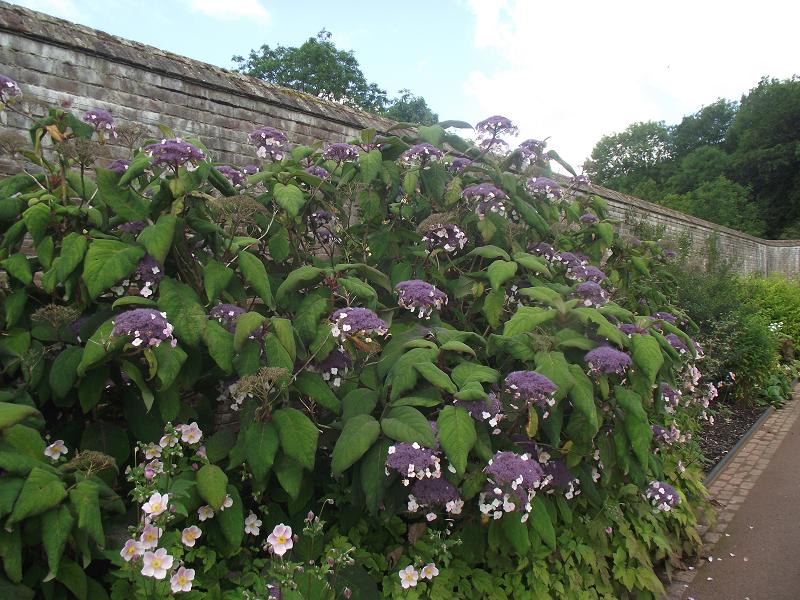
Botanical
Name: Hydrangea macrophylla
Common Name: big leaf hydrangea
Family: Hydrangaceae
Distribution/Origin: Asia
Leaf: ovate, serrated margin, acute apex
Bud: alternate
Flower: globose corymb (multiple), blue, flowers on 2 year wood are incomplete.
Fruit/Seed:
Stem/Bark: lenticiled
Size: 9’ height, 9’ spread
Habit: multi stemmed, suckering, vigorous
Form: mounding
Soil Conditions: well drained, adaptable to variety of soil types
Moisture: even moisture
Sun: full sun to semi shade
Exposure: can tolerate wind
Landscape Use: can be pruned to hedge, background shrub, accent plant
Notes: the young leaves when dried can be brewed into a tea called “tea of heaven” and is used in Buddhist ceremonies
Common Name: big leaf hydrangea
Family: Hydrangaceae
Distribution/Origin: Asia
Leaf: ovate, serrated margin, acute apex
Bud: alternate
Flower: globose corymb (multiple), blue, flowers on 2 year wood are incomplete.
Fruit/Seed:
Stem/Bark: lenticiled
Size: 9’ height, 9’ spread
Habit: multi stemmed, suckering, vigorous
Form: mounding
Soil Conditions: well drained, adaptable to variety of soil types
Moisture: even moisture
Sun: full sun to semi shade
Exposure: can tolerate wind
Landscape Use: can be pruned to hedge, background shrub, accent plant
Notes: the young leaves when dried can be brewed into a tea called “tea of heaven” and is used in Buddhist ceremonies


Botanical
Name: Hydrangea paniculata
Common Name: peegee hydrangea
Family: Hydrangaceae
Distribution/Origin:
Leaf: broadly oval to ovate, toothed margin
Bud: alternate
Flower: conical, terminal flower pannicles
Fruit/Seed: dry, pinkish brown fruit
Stem/Bark: lenticels, exfoliating, ridged and plated with age
Size: 8-10’ height, 8’ spread
Habit: vigorous, upright
Form: round, globose
Soil Conditions: organically rich, well drained
Moisture: medium moisture
Sun: full sun to partial shade
Exposure: thrives in urban conditions, very hardy
Landscape Use: hedge, shrub border, garden bed
Notes: the only hydrangea that can be pruned into a tree form
Common Name: peegee hydrangea
Family: Hydrangaceae
Distribution/Origin:
Leaf: broadly oval to ovate, toothed margin
Bud: alternate
Flower: conical, terminal flower pannicles
Fruit/Seed: dry, pinkish brown fruit
Stem/Bark: lenticels, exfoliating, ridged and plated with age
Size: 8-10’ height, 8’ spread
Habit: vigorous, upright
Form: round, globose
Soil Conditions: organically rich, well drained
Moisture: medium moisture
Sun: full sun to partial shade
Exposure: thrives in urban conditions, very hardy
Landscape Use: hedge, shrub border, garden bed
Notes: the only hydrangea that can be pruned into a tree form


Botanical Name: Hydrangea
quercifolia
Common Name: oak leaf hydrangea
Family: Hydrangaceae
Distribution/Origin: south eastern United States
Leaf: oak shaped, deep lobes, silvery underside
Bud: alternate
Flower: open pannicle, white, mix of fertile/infertile flowers
Fruit/Seed: dry, oval in shape, terminal buds are pubescent
Stem/Bark: cinnamon colored with age, felt like brown bark in youth
Size: 6-8’ height, 6-8’ spread
Habit: suckering, multi stemmed, shrub, open, upright
Form: mounding
Soil Conditions: organically rich, appreciates a summer mulch, well drained
Moisture: thrives in moist soils
Sun: full sun to partial shade
Exposure:
Landscape Use: mixed shrub border, open woodland garden, backgrounds, accents
Notes:
Common Name: oak leaf hydrangea
Family: Hydrangaceae
Distribution/Origin: south eastern United States
Leaf: oak shaped, deep lobes, silvery underside
Bud: alternate
Flower: open pannicle, white, mix of fertile/infertile flowers
Fruit/Seed: dry, oval in shape, terminal buds are pubescent
Stem/Bark: cinnamon colored with age, felt like brown bark in youth
Size: 6-8’ height, 6-8’ spread
Habit: suckering, multi stemmed, shrub, open, upright
Form: mounding
Soil Conditions: organically rich, appreciates a summer mulch, well drained
Moisture: thrives in moist soils
Sun: full sun to partial shade
Exposure:
Landscape Use: mixed shrub border, open woodland garden, backgrounds, accents
Notes:


Botanical Name: Hydrangea
serrata
Common Name: lacecap hydrangea
Family: Hydrangaceae
Distribution/Origin: Asia
Leaf: serrate margins, ovate, dull green
Bud: alternate
Flower: corymb, flattop, flowers are perfect, insect pollinated
Fruit/Seed: oval fruits
Stem/Bark: exfoliating, cinnamon colored
Size: 2-4’ height, 2-4’ spread
Habit: suckering, multi stemmed
Form: broad, mounding, compact
Soil Conditions: rich, well drained
Moisture: consistently moist
Sun: cool, semi shade
Exposure: sheltered
Landscape Use: shrub border, mass plantings, accent border, shaded spots
Notes: most hydrangeas color is affected by the pH of the soil (blue is acidic, pink-white is neutral to alkaline)
Common Name: lacecap hydrangea
Family: Hydrangaceae
Distribution/Origin: Asia
Leaf: serrate margins, ovate, dull green
Bud: alternate
Flower: corymb, flattop, flowers are perfect, insect pollinated
Fruit/Seed: oval fruits
Stem/Bark: exfoliating, cinnamon colored
Size: 2-4’ height, 2-4’ spread
Habit: suckering, multi stemmed
Form: broad, mounding, compact
Soil Conditions: rich, well drained
Moisture: consistently moist
Sun: cool, semi shade
Exposure: sheltered
Landscape Use: shrub border, mass plantings, accent border, shaded spots
Notes: most hydrangeas color is affected by the pH of the soil (blue is acidic, pink-white is neutral to alkaline)

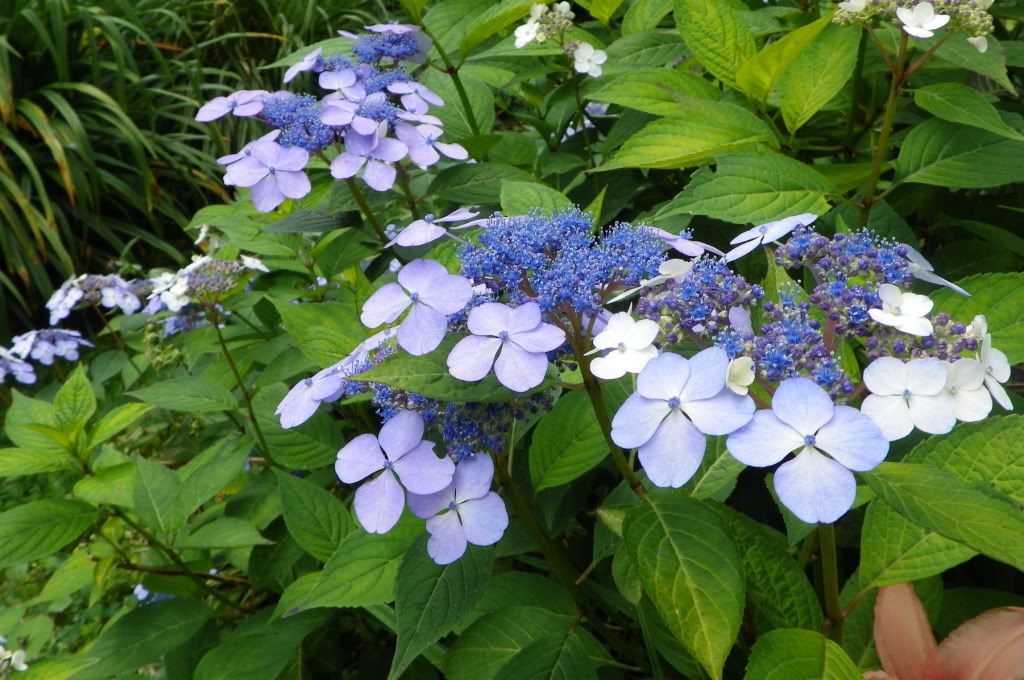
Botanical Name: Kirengeshoma
palmata
Common Name: yellow wax bells
Family: Hydrangaceae
Distribution/Origin: Asia
Leaf: alternate, large palmate, shallow lobes, circular, serrate margins
Bud: decusate
Flower: narrow, drooping, waxy bell shaped, yellow
Fruit/Seed: three horned, brown seed capsules
Stem/Bark: erect purplish stems
Size: 3-4’ height, 2-3’ spread
Habit: vigorous, upright, un-branched shoots, clumping, densely rhizomatous
Form: upright, horizontal tiered leaves
Soil Conditions: acidic, humusy, well drained
Moisture: consistent moisture
Sun: shade adapted, full or partial
Exposure: sheltered from hot sun
Landscape Use: shaded border, woodland garden, interesting feature
Notes:
Common Name: yellow wax bells
Family: Hydrangaceae
Distribution/Origin: Asia
Leaf: alternate, large palmate, shallow lobes, circular, serrate margins
Bud: decusate
Flower: narrow, drooping, waxy bell shaped, yellow
Fruit/Seed: three horned, brown seed capsules
Stem/Bark: erect purplish stems
Size: 3-4’ height, 2-3’ spread
Habit: vigorous, upright, un-branched shoots, clumping, densely rhizomatous
Form: upright, horizontal tiered leaves
Soil Conditions: acidic, humusy, well drained
Moisture: consistent moisture
Sun: shade adapted, full or partial
Exposure: sheltered from hot sun
Landscape Use: shaded border, woodland garden, interesting feature
Notes:


Botanical Name: Metasequoia
glyptostroboides
Common Name: dawn redwood
Family: Cupresaceae
Distribution/Origin: central and western China
Leaf: soft, pale, green linear leaves, compound, opposite, even pinnate
Bud: alternate buds, scaled, yellowish, opposite
Flower: male cone
Fruit/Seed: cone, winged seeds
Stem/Bark: “armpits” are formed under each branch, wide buttresses on lower trunk, fibrous
Size: 70-100’ height, 15-25’ spread
Habit: upright, spreading
Form: pyramidal, conical
Soil Conditions: tolerates wet or dry soil, humusy, well drained
Moisture: medium to wet
Sun: full sun
Exposure: sheltered or exposed
Landscape Use: street tree, rain garden, parks, needs large space
Notes: the dawn redwood was originally considered extinct
Common Name: dawn redwood
Family: Cupresaceae
Distribution/Origin: central and western China
Leaf: soft, pale, green linear leaves, compound, opposite, even pinnate
Bud: alternate buds, scaled, yellowish, opposite
Flower: male cone
Fruit/Seed: cone, winged seeds
Stem/Bark: “armpits” are formed under each branch, wide buttresses on lower trunk, fibrous
Size: 70-100’ height, 15-25’ spread
Habit: upright, spreading
Form: pyramidal, conical
Soil Conditions: tolerates wet or dry soil, humusy, well drained
Moisture: medium to wet
Sun: full sun
Exposure: sheltered or exposed
Landscape Use: street tree, rain garden, parks, needs large space
Notes: the dawn redwood was originally considered extinct

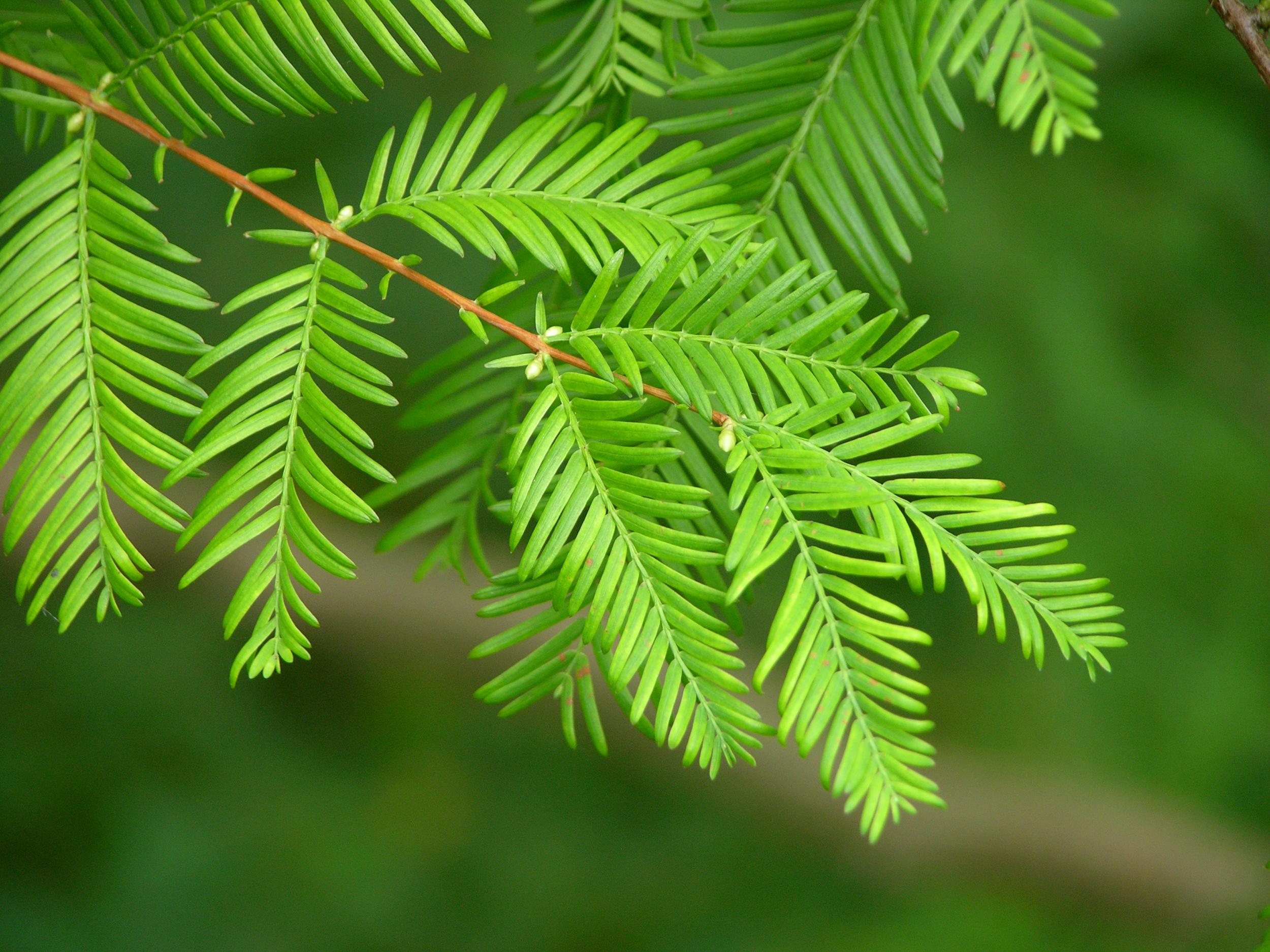
Botanical Name: Myrica
californica
Common Name: California gale
Family: Myricaceae
Distribution/Origin: west coast North America
Leaf: pubescent new growth, alternate spiralled leaves, serrated margins, sticky
Bud: multi terminal, ovoid, red in color
Flower: small bottle brush white spikes
Fruit/Seed: wrinkled purple berry, wax coating
Stem/Bark: heavily lenticiled, root nodules containing nitrogen fixing microorganisms, close grained, hard and heavy, lightly fissured
Size: 10-15m height, 7-10m spread
Habit: lateral arching branches, sprawling
Form: large mounds in full growth
Soil Conditions: can grow in poor soils due to nitrogen fixing root nodules, well draining
Moisture: even moisture
Sun: full sun to partial shade
Exposure:
Landscape Use: seaside windbreak, background planting
Notes: wax may be extracted from fruits and made into candles and soap
Common Name: California gale
Family: Myricaceae
Distribution/Origin: west coast North America
Leaf: pubescent new growth, alternate spiralled leaves, serrated margins, sticky
Bud: multi terminal, ovoid, red in color
Flower: small bottle brush white spikes
Fruit/Seed: wrinkled purple berry, wax coating
Stem/Bark: heavily lenticiled, root nodules containing nitrogen fixing microorganisms, close grained, hard and heavy, lightly fissured
Size: 10-15m height, 7-10m spread
Habit: lateral arching branches, sprawling
Form: large mounds in full growth
Soil Conditions: can grow in poor soils due to nitrogen fixing root nodules, well draining
Moisture: even moisture
Sun: full sun to partial shade
Exposure:
Landscape Use: seaside windbreak, background planting
Notes: wax may be extracted from fruits and made into candles and soap
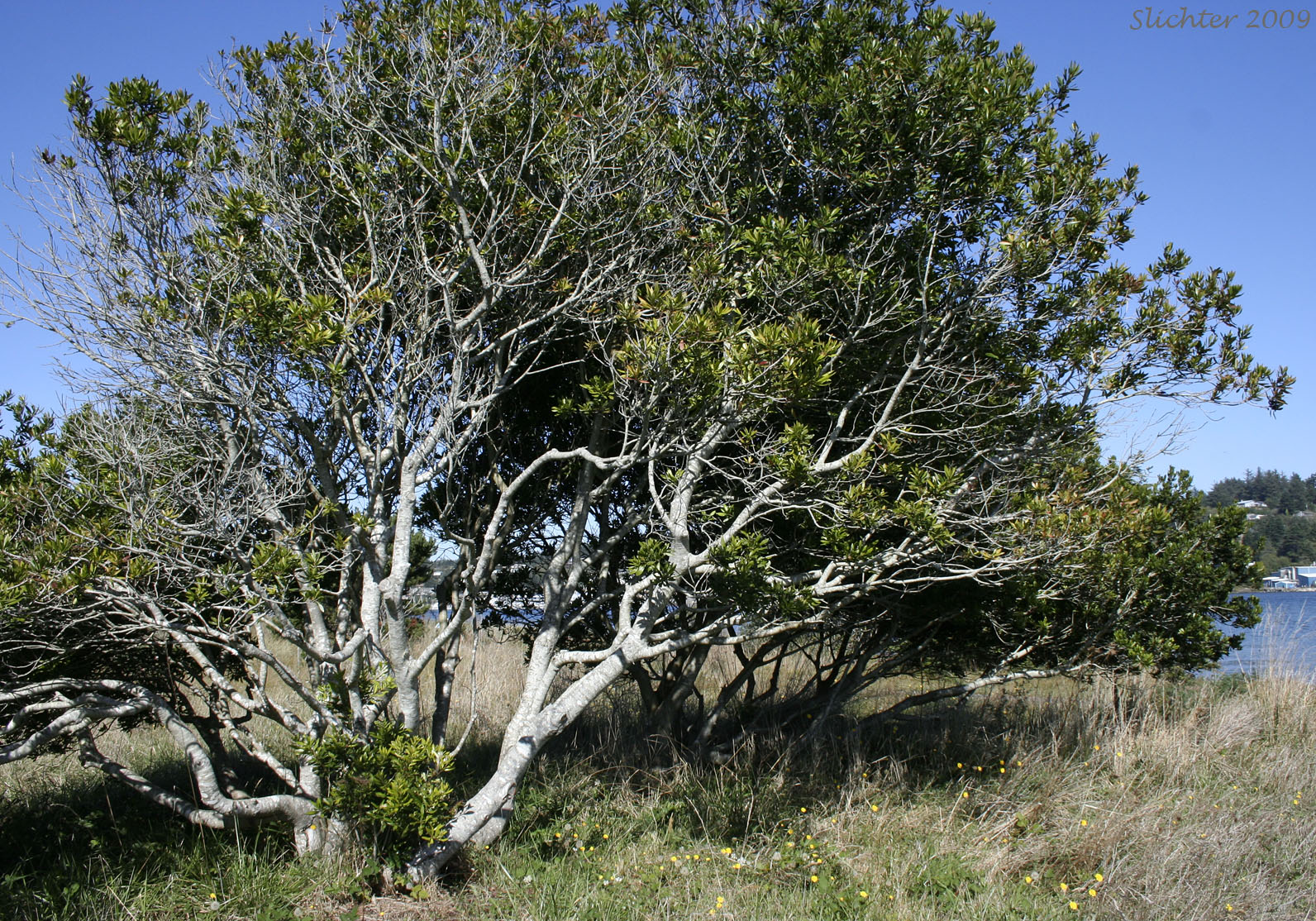
Botanical Name: Nyssa
sylvatica
Common Name: Tupelo
Family: Nyssaceae
Distribution/Origin: North America
Leaf: ovate, entire margins, red petiole, glabrous, smooth
Bud: alternate
Flower: small greenish white, insignificant
Fruit/Seed: blue/black drupes
Stem/Bark: deeply fissured, grey, corky
Size: 66-82’ height, 40’ spread
Habit: horizontal branching, branch line undulating
Form: loosely oval, in juvenility pyramidal
Soil Conditions: can grow in standing water, adaptable, deep, acidic
Moisture: even moisture
Sun: full sun to partial shade
Exposure: can handle windy slopes, has taproots and roots deeply
Landscape Use: windbreak, forest garden
Notes: fruits attract many migrating birds
Common Name: Tupelo
Family: Nyssaceae
Distribution/Origin: North America
Leaf: ovate, entire margins, red petiole, glabrous, smooth
Bud: alternate
Flower: small greenish white, insignificant
Fruit/Seed: blue/black drupes
Stem/Bark: deeply fissured, grey, corky
Size: 66-82’ height, 40’ spread
Habit: horizontal branching, branch line undulating
Form: loosely oval, in juvenility pyramidal
Soil Conditions: can grow in standing water, adaptable, deep, acidic
Moisture: even moisture
Sun: full sun to partial shade
Exposure: can handle windy slopes, has taproots and roots deeply
Landscape Use: windbreak, forest garden
Notes: fruits attract many migrating birds
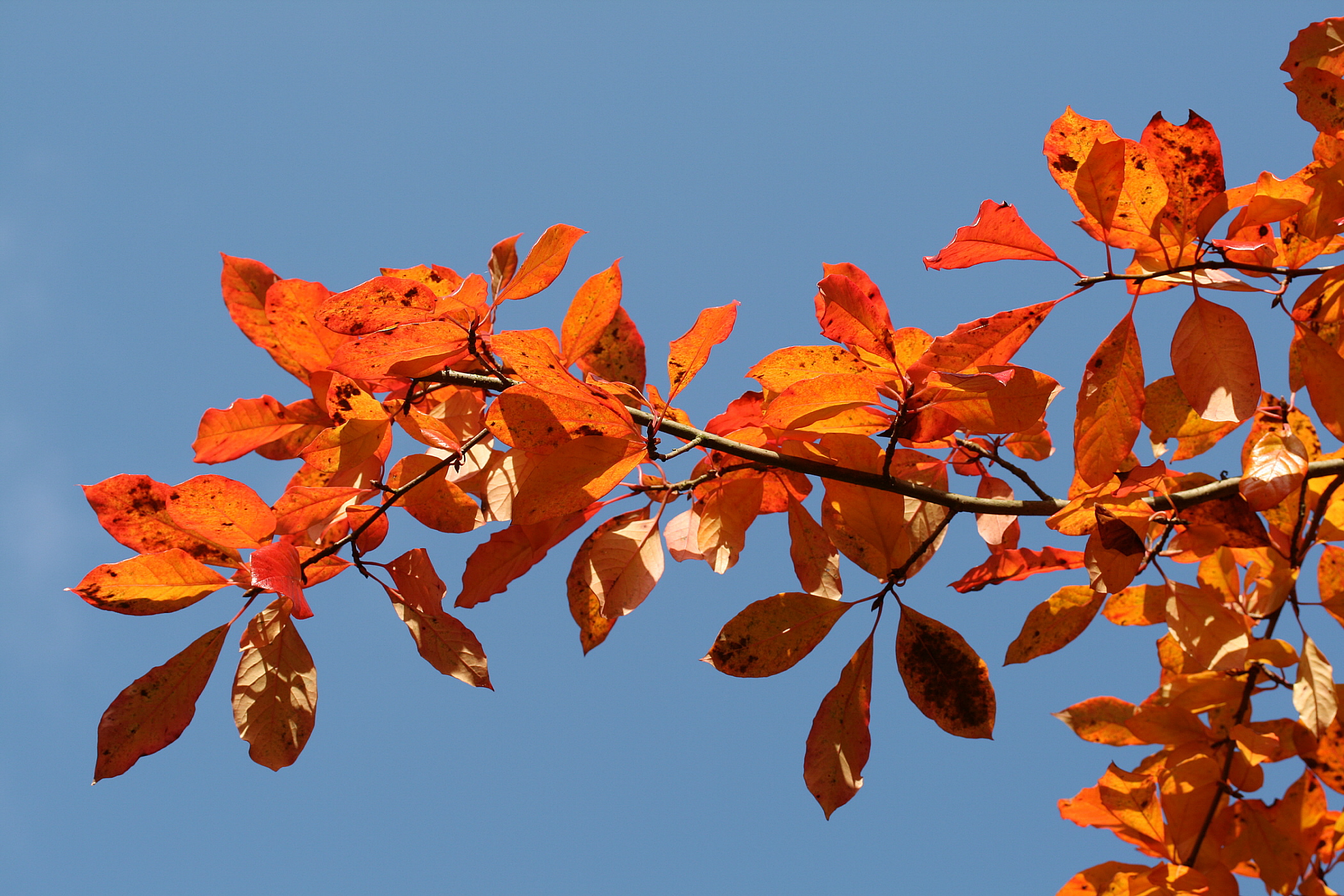
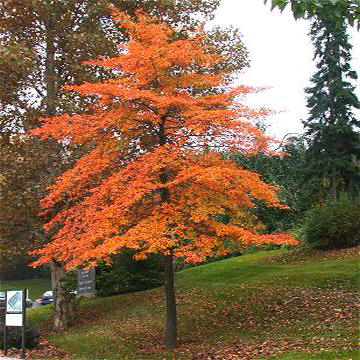
Botanical Name: Quercus
palustris
Common Name: pin oak
Family: Fagaceae
Distribution/Origin: North America
Leaf: deep lobes, holds leaf through winter, pubescent on undersides
Bud: alternate, terminal buds in clusters, scaled
Flower: catkins, require another oak for pollination
Fruit/Seed: acorns, glabrous, globoid in shape
Common Name: pin oak
Family: Fagaceae
Distribution/Origin: North America
Leaf: deep lobes, holds leaf through winter, pubescent on undersides
Bud: alternate, terminal buds in clusters, scaled
Flower: catkins, require another oak for pollination
Fruit/Seed: acorns, glabrous, globoid in shape
Stem/Bark: brownish grey, rough textured, slightly
furrowed on central trunk, branches are grey and more smooth, lenticils
Size: 59-72’ height, 26-46’ spread
Habit: horizontal middle, upright on top
Form: pyramidal
Soil Conditions: can handle compaction
Moisture: even moisture
Sun: full sun
Exposure: pollution and strong wind tolerance
Landscape Use: street tree, woodland garden canopy
Notes: the leaves have long “pins” on leaf tips, hence the common name
Size: 59-72’ height, 26-46’ spread
Habit: horizontal middle, upright on top
Form: pyramidal
Soil Conditions: can handle compaction
Moisture: even moisture
Sun: full sun
Exposure: pollution and strong wind tolerance
Landscape Use: street tree, woodland garden canopy
Notes: the leaves have long “pins” on leaf tips, hence the common name


Botanical Name: Rogersia
pinnata
Common Name: Rogersia
Family: Saxifragaceae
Distribution/Origin: east Asia
Leaf: emerges bronze, compound leaf, deeply and palmately divided
Bud: dark red in color, alternate flower buds, terminal buds cluster
Flower: star shaped flowers, large conical patterns, central axis
Fruit/Seed: purple capsule
Stem/Bark: reddish green stems
Size: 36-48” height, 24-36” spread
Habit: rhyzominus, clumping
Form: mass clumps
Soil Conditions: the richer the soil; the more sun it will tolerate, well drained but moist
Moisture: consistently moist
Sun: partial shade
Exposure: sheltered
Landscape Use: shaded areas, wet sites
Notes:
Common Name: Rogersia
Family: Saxifragaceae
Distribution/Origin: east Asia
Leaf: emerges bronze, compound leaf, deeply and palmately divided
Bud: dark red in color, alternate flower buds, terminal buds cluster
Flower: star shaped flowers, large conical patterns, central axis
Fruit/Seed: purple capsule
Stem/Bark: reddish green stems
Size: 36-48” height, 24-36” spread
Habit: rhyzominus, clumping
Form: mass clumps
Soil Conditions: the richer the soil; the more sun it will tolerate, well drained but moist
Moisture: consistently moist
Sun: partial shade
Exposure: sheltered
Landscape Use: shaded areas, wet sites
Notes:

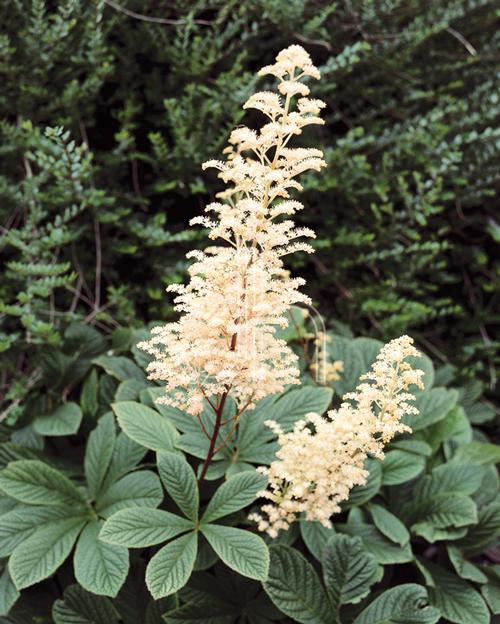
Botanical Name: Salix matsudana ‘Tortuosa’
Common Name: tortured willow
Family: Saliaceae
Distribution/Origin: Japan
Leaf: solitary, lineal, serrate margins, lance shaped, curled and twisted
Bud: alternate
Flower: pale yellow female catkins
Fruit/Seed: green, pointed, clustered catkins
Stem/Bark: rough brown fissured bark with age, lenticiled
Size: 20-30’ height, 10-15’ spread
Habit: contorted twigs, multi-stemmed
Form: upright, vase like
Soil Conditions: average, well drained
Moisture: tolerates wet soils
Sun: full sun to partial shade
Exposure:
Landscape Use: background tree, visual interest, forest garden
Notes: named for the strange habit of the twigs to twist and contort
Common Name: tortured willow
Family: Saliaceae
Distribution/Origin: Japan
Leaf: solitary, lineal, serrate margins, lance shaped, curled and twisted
Bud: alternate
Flower: pale yellow female catkins
Fruit/Seed: green, pointed, clustered catkins
Stem/Bark: rough brown fissured bark with age, lenticiled
Size: 20-30’ height, 10-15’ spread
Habit: contorted twigs, multi-stemmed
Form: upright, vase like
Soil Conditions: average, well drained
Moisture: tolerates wet soils
Sun: full sun to partial shade
Exposure:
Landscape Use: background tree, visual interest, forest garden
Notes: named for the strange habit of the twigs to twist and contort


Botanical Name: Salix babylonica
Common Name: weeping willow
Family: Saliaceae
Distribution/Origin: southwest Asia to Europe
Leaf: alternate, spirally arranged, narrow, light green, finely serrate margins, accuminate tips
Bud: small, appressed, covered by single cap like scale, terminal buds are lacking
Flower: catkins
Fruit/Seed: cluster of valve like capsules containing many fine cottony seeds
Stem/Bark: grey to black in color, branches are typically green to brown, irregularly furrowed
Size: 35-50’ height, 35-50’ spread
Habit: pendulous branching
Form: weeping form, round crown, large sweeping branches
Soil Conditions: can grow in wet sites, well draining, wide tolerance of soils
Moisture: even moisture
Sun: full sun to partial shade
Exposure: moist areas, some wind tolerance
Landscape Use: rain garden, focal point, large spaces, along ponds or streams
Notes: mistaken to be the biblical willow of Babylon by Carl Linnaeus, the trees of Babylon would’ve actually been poplars, which aren’t willows but are a part of the willow family
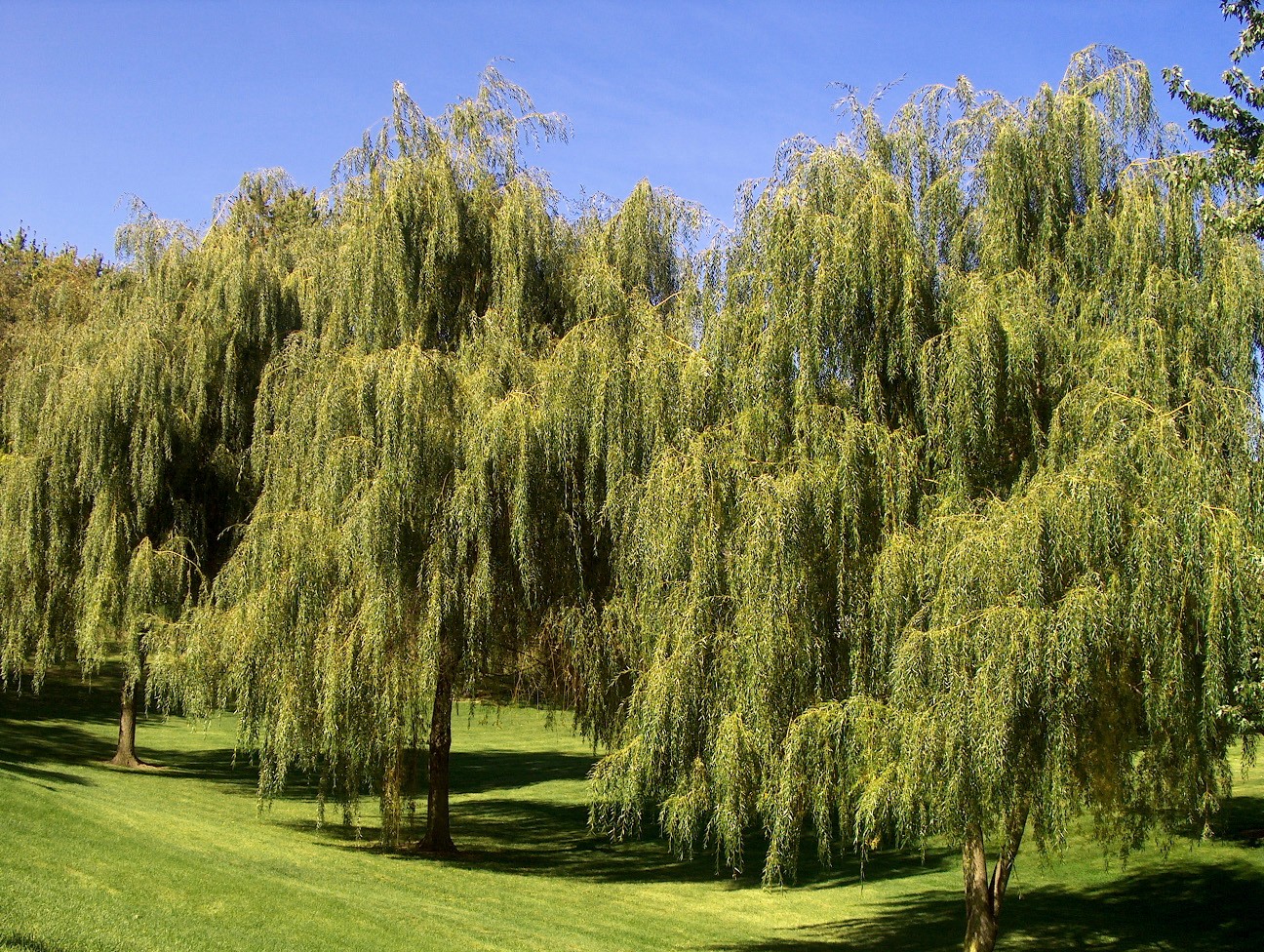
Common Name: weeping willow
Family: Saliaceae
Distribution/Origin: southwest Asia to Europe
Leaf: alternate, spirally arranged, narrow, light green, finely serrate margins, accuminate tips
Bud: small, appressed, covered by single cap like scale, terminal buds are lacking
Flower: catkins
Fruit/Seed: cluster of valve like capsules containing many fine cottony seeds
Stem/Bark: grey to black in color, branches are typically green to brown, irregularly furrowed
Size: 35-50’ height, 35-50’ spread
Habit: pendulous branching
Form: weeping form, round crown, large sweeping branches
Soil Conditions: can grow in wet sites, well draining, wide tolerance of soils
Moisture: even moisture
Sun: full sun to partial shade
Exposure: moist areas, some wind tolerance
Landscape Use: rain garden, focal point, large spaces, along ponds or streams
Notes: mistaken to be the biblical willow of Babylon by Carl Linnaeus, the trees of Babylon would’ve actually been poplars, which aren’t willows but are a part of the willow family


Botanical Name: Salix purpurea ‘Nana’
Common Name: Arctic willow
Family: Saliaceae
Distribution/Origin: Syberia, northern Europe, northern hemisphere
Leaf: blue green in color, densely arranged on thin stems, alternate to spiraled, serrulate
Bud: shiny red buds, alternate, single bracts beneath buds
Flower: white female and male catkins, stiff, yellow
Fruit/Seed: fruits containing small seeds on female plants
Stem/Bark: purple stems, branch repeatedly in dense canopy
Size: 3-5’ height, 3-5’ spread
Habit: multi stemmed, dense, twiggy
Form: mounding, compact, rounded
Soil Conditions: adapted to a wide variety
Moisture: wet to dry
Sun: full sun
Exposure:
Landscape Use: hedge, rain garden, beds
Notes: one of the common names in use is dwarf purple “osier”, osier is a medieval term for willows with long shoots that are used for basketry. On that note, this is an excellent plant to use if you need to weave a basket.
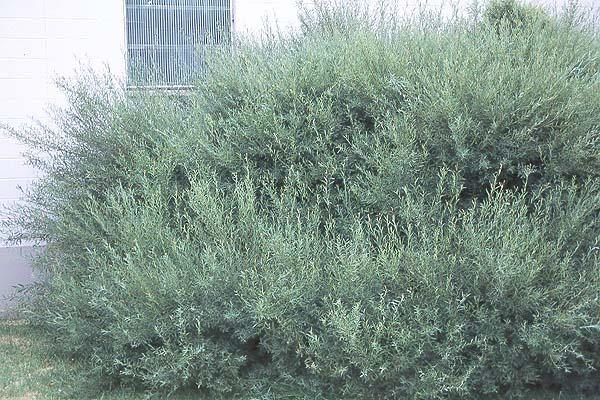

Common Name: Arctic willow
Family: Saliaceae
Distribution/Origin: Syberia, northern Europe, northern hemisphere
Leaf: blue green in color, densely arranged on thin stems, alternate to spiraled, serrulate
Bud: shiny red buds, alternate, single bracts beneath buds
Flower: white female and male catkins, stiff, yellow
Fruit/Seed: fruits containing small seeds on female plants
Stem/Bark: purple stems, branch repeatedly in dense canopy
Size: 3-5’ height, 3-5’ spread
Habit: multi stemmed, dense, twiggy
Form: mounding, compact, rounded
Soil Conditions: adapted to a wide variety
Moisture: wet to dry
Sun: full sun
Exposure:
Landscape Use: hedge, rain garden, beds
Notes: one of the common names in use is dwarf purple “osier”, osier is a medieval term for willows with long shoots that are used for basketry. On that note, this is an excellent plant to use if you need to weave a basket.


Botanical Name: Schizophragma
hydrangeoides
Common Name: Japanese climbing hydrangea
Family: Hydrangaceae
Distribution/Origin: Japan
Leaf: cordately shaped, pubescent red petioles, serrate margins, broadly ovate in shape, drip tip
Bud: alternate
Flower: single showy bracts, loose pannicle, one solitary heart shaped sepal
Fruit/Seed: 10 ribbed capsule
Stem/Bark: brown, root like hold fasts along inter nodes
Size: 20-30’ height, 10-12’ spread
Habit: open, climbing liana, spreading
Form: variable, depends on structure
Soil Conditions: well drained, fertile
Moisture: wet to dry
Sun: full sun to partial shade
Exposure: can handle deep shade to sun
Landscape Use: climbing structure, brick, concrete, pergola, arbor
Notes: The genus name Schizophragma comes from the Greek for "divided wall", referring to the split walls of the fruit.


Common Name: Japanese climbing hydrangea
Family: Hydrangaceae
Distribution/Origin: Japan
Leaf: cordately shaped, pubescent red petioles, serrate margins, broadly ovate in shape, drip tip
Bud: alternate
Flower: single showy bracts, loose pannicle, one solitary heart shaped sepal
Fruit/Seed: 10 ribbed capsule
Stem/Bark: brown, root like hold fasts along inter nodes
Size: 20-30’ height, 10-12’ spread
Habit: open, climbing liana, spreading
Form: variable, depends on structure
Soil Conditions: well drained, fertile
Moisture: wet to dry
Sun: full sun to partial shade
Exposure: can handle deep shade to sun
Landscape Use: climbing structure, brick, concrete, pergola, arbor
Notes: The genus name Schizophragma comes from the Greek for "divided wall", referring to the split walls of the fruit.


Botanical Name: Taxodium distichum
Common Name: swamp cypress
Family: Cupressaceae
Distribution/Origin: south eastern United States
Leaf: alternate and linear, flat blades spirally arranged on a stem, lying in horizontal patterns
Bud: alternate red to brown buds near end of twig
Flower: slender tassle like structures, male and female
Fruit/Seed: male reproductive drupes, female is upright, oval, hard, woody sphere
Stem/Bark: grey brown to red brown, thin and fibrous, stringy texture, shallow ridged and narrow furrows
Size: 100-120’ height, 25-35’ spread
Habit: central leader, main trunks are surrounded by “cypress knees”
Form: pyramidal when older, forks at top in youth
Soil Conditions: well drained, well balanced soil
Moisture: high drought tolerance, prefers it moist
Sun: full sun
Exposure: relatively tough tree
Landscape Use: hedge, large parking lot islands, pond sites, streams, large open spaces
Notes: loses its leaves in the winter, hence its other common name “bald cypress”

Common Name: swamp cypress
Family: Cupressaceae
Distribution/Origin: south eastern United States
Leaf: alternate and linear, flat blades spirally arranged on a stem, lying in horizontal patterns
Bud: alternate red to brown buds near end of twig
Flower: slender tassle like structures, male and female
Fruit/Seed: male reproductive drupes, female is upright, oval, hard, woody sphere
Stem/Bark: grey brown to red brown, thin and fibrous, stringy texture, shallow ridged and narrow furrows
Size: 100-120’ height, 25-35’ spread
Habit: central leader, main trunks are surrounded by “cypress knees”
Form: pyramidal when older, forks at top in youth
Soil Conditions: well drained, well balanced soil
Moisture: high drought tolerance, prefers it moist
Sun: full sun
Exposure: relatively tough tree
Landscape Use: hedge, large parking lot islands, pond sites, streams, large open spaces
Notes: loses its leaves in the winter, hence its other common name “bald cypress”


No comments:
Post a Comment